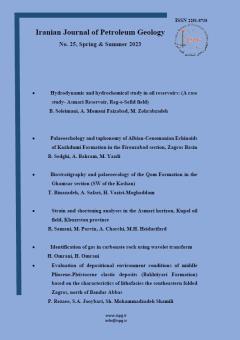Strain and shortening analyses in the Asmari horizon, Kupal oil field, Khuzestan province
Subject Areas : Geoscience Fields in relation with Petroleum GeologyBabak Samani 1 * , Mina Parvin 2 , Abbas Charchi 3 , Mohammad Hossein Heydarifard 4
1 - Associate professor, Faculty of Earth science, Shahid Chamran University of Ahvaz, Ahvaz, Iran
2 - Faculty of Earth science, Shahid Chamran University of Ahvaz, Ahvaz, Iran
3 - Faculty of Earth Sciences, Shahid Chamran University of Ahvaz
4 - National Iranian South Oil Company, Ahvaz, Iran
Keywords: Dezful embayment, Kupal oil field, Fold aspect ratio, Strain ratio, Shortening ,
Abstract :
Kupal Oil Field is one of the important oil fields in the Zagros Basin, located in the eastern part of the Dezful embayment, adjacent to Aghajari Oil Field and Marun Oil Field. Some characteristics of the fold elements, such as the fold interval angle and axial surface, were determined in the Asmari folded horizon using the interpreted seismic profiles. Based on the deviation of the axial surface from the vertical surface and determination of shear angle and shear strain, minimum and maximum quadratic stretch and strain ratio (R) values were calculated in different parts of the anticline. With application of graphical functions the amounts of fold aspect ratio were determined along the anticline. Base on the results, the amounts of shear strain varies from 0.01 to 0.09 in deferent parts of anticline. Also results show the amounts of strain ratio in range of 1.25 to 1.38 and shortening about 5% to 17% in different parts of the kupal anticline oil field.
[1] ALAVI, M., 1994, Tectonics of the Zagros orogenic belt of Iran: new data and interpretation. Tectonophysics, 229, 211–238.
[2] ALAVI, M., 2004, Regional stratigraphy of the Zagros fold-thrust belt of Iran, and its proforeland evolution. American Journal of Science 304, 1–20.
[3] ALAVI, M., 2007, Structures of the Zagros fold-thrust belt in Iran. American journal of science, vol. 307, 1064-1095.
[4] AL-AZZAWI N. K. 2008, Local Shortening of Folds and Detachment Surface Depth with Examples from the Foreland Belt of Iraq. Iraqi Journal of Earth Sciences- Vol. 8. No. 1- May
[5] BERBERIAN, M., 1995, Master ‘blind’ thrust faults hidden under the Zagros folds: active basement tectonics and surface morphotectonics, Tectonophysics, 241, 193–224.
[6] BERBERIAN, M., KING, G.C.P., 1981, Towards a paleogeography and tectonic evolution of Iran. Canadian Journal of Earth Sciences 18, 210–265.
[7] BLANCE, E.J.P., ALLEN, M.B., INGER, S., HASSANI, H., 2003, Structural styles in the Zagros Simple Folded Zone, Iran. J. Geol. Soc. 160, 401–412. doi:10.1144/0016-764902-110.
[8] BROWN, D., ALVAREZ - MARRON, J., PEREZ - ESTAFIN, A., GOROZJANIN, Y., BARYSHEVA, V., PUCHKOV, V., 1997, Geometric and kinematic evolution of the foreland thrust and fold belt in the southern Urals. Tectonics, VOL. 16, NO. 3, PAGES 551-562, JUNE 1997.
[9] ESPURT, N., HIPPOLYTE, J.C., SAILLARD, M., BELLIER, O., 2012, Geometry and kinematic evolution of a long-living foreland structure inferred from field data and cross section balancing, the Sainte-Victoire System, Provence, France. Tectonics, VOL. 31, TC4021, doi:10.1029/2011TC002988.
[10] FREHNER, M.D., GRASEMANN, B., 2012, Mechanical versus kinematical shortening reconstructions of the Zagros High Folded Zone (Kurdistan region of Iraq), Tectonics, 31, TC3002, doi:10.1029/2011TC003010.
[11] FOSSEN, H., 2016, Structural Geology. Cambridge University Press.
[12] GHASSEMI, M. R., SCHMALHOLZ, S. M., GHASSEMI, A. R., 2010, Kinematics of constant arc length folding for different fold shapes. Journal of Structural Geology . 32 (2010) 755e765.
[13] IMBER J, PERRY T, JONES R, WIGHTMAN RH 2012, Do cataclastic deformation bands form parallel to lines of no finite elongation (LNFE) or zero extension direction? Journal of Structural Geology. 45:158–172.
[14] KESHAVARZ, S., FAGHIH, F., 2020, Heterogeneous sub–simple deformation in the Gol–e–Gohar shear zone (Zagros, SW Iran): insights from microstructural and crystal fabric analyses. International Journal of Earth Sciences. 109, 421–438.
[15] KODABAKHSHNEZHAD, A., ARIAN, M., POURKERMANI, M., 2015, Folding mechanism in the Asmari anticline, Zagros, Iran, Open Journal of Geology, 5, 197-208.
[16] MCQUARRIE, N., 2004, Crustal scale geometry of the Zagros fold–thrust belt, Iran. Journal of Structural Geology 26, 519–535.
[17] MOLINARO, M., ZEYEN, H., LAURENCIN, X., 2005, Lithospheric structure beneath the southeastern Zagros Mountains, Iran: Recent slab break-off? Terra Nova 17, 1–6. doi:10.1111/j.1365-3121.2004.00575.x.
[18] RAMSAY, JG, HUBER, MI., 1983, The techniques of modern structural geology, 1: strain analysis. Academic Press, London.
[19] SAMANI, B., 2017, Deformation flow analysis and symmetry of Goushti shear zone, Sanandaj-Sirjan metamorphic belt, Iran. Geopersia. 7, 117-130.
[20] SARKARINEJAD, K., AZIZI, A., 2008, Slip partitioning and inclined dextral transpression along the Zagros Thrust System, Iran. Journal of Structural Geology, 30: 116–136.
[21] SARKARINEJAD, K, SAMANI, B, FAGHIH, A, GRASEMANN, B, MORADIPOOR, M., 2010, Implications of strain and vorticity of flow analyses to interpret the kinematics of an oblique convergence event (Zagros Mountains, Iran). Journal of Asian Earth Sciences, 38:34-43.
[22] SARKARINEJAD, K., KESHAVARZ, S., FAGHIH, A., SAMANI, B., 2017, Kinematic analysis of rock flow and deformation temperature of the Sirjan thrust sheet, Zagros Orogen, Iran. Geological Magazine. 154, 147–165.
[23] SHERKATI, S., LETOUZEY, J., FRIZON DE LAMOTTE, D., 2006. Central Zagros fold-thrust belt (Iran): new insights from seismic data, field observation, and sandbox modeling. Tectonics 25, TC4007. doi:10.1029/2004TC001766.
[24] SHERKATI, S., MOLINARO, M., FRIZON DELAMOTTE, D., LETOUZEY, J., 2005, Detachment folding in the Central and Eastern Zagros fold-belt (Iran): salt mobility, multiple detachments and late basement control. Journal of Structural Geology. 27,1680–1696.
[25] STOCKLIN, J., 1968, Structural history and tectonics of Iran, a review, A. A. P. G. Bull., 52(7), PP. 1229-1258.

